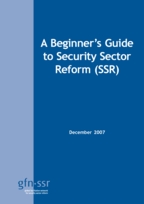Security and development overview
There are many different ideas about what security means and whose security donors and development practitioners should focus on. This guide uses DFID’s concept of security, defined as the physical security of poor people.
Page contents
- Where is a good place to start?
- What is security?
- Links between security and development
- Donor strategies
- Responsibility to protect
- Peacekeeping
- Human rights and security
- Additional information resources
Where is a good place to start?
Stewart, F., 2004, ‘Development and Security’, Centre for Research on Inequality, Human Security and Ethnicity (CRISE) Working Paper 3, Queen Elizabeth House, Oxford University
What are the connections between security and development? This paper from the Centre for Research on Inequality, Human Security and Ethnicity argues that there is a symbiotic relationship between the two. Traditional interpretations of security that focus on military solutions are inadequate for developing countries and for preventing global terrorism. The paper instead interprets security as human security, and within this category focuses on political violence as an important source of insecurity.
Full document: available online
Uvin, P, 2002, ‘The Development / Peacebuilding Nexus: a Typology and History of Changing Paradigms’, Journal of Peacebuilding and Development, vol.1, no.1
The nexus between development and peace has become a central focus of development thinking and practice. What should the relationship between development aid and peace building be? This article from the Journal of Peace building and Development presents and critiques a typology of seven ways in which this interaction has historically been conceived.
Full document: available via document delivery. Please see document summary.
Department for International Development, Ministry of Defence and Foreign Commonwealth Office, undated, ‘GCPP SSR Strategy 2004-2005’, DFID, Ministry of Defence and Foreign and Commonwealth Office, London
Security sector reform (SSR) is fundamental to the promotion of peace, stability and sustainable development. This document outlines the joint SSR strategy of the UK Foreign and Commonwealth Office (FCO), the UK Ministry of Defence (MoD) and the UK Department for International Development (DFID). The prevention of violent conflict and the promotion of peace in fragile countries require a coherent response across the UK government. A joint SSR strategy helps to achieve such coherence and to refine the UK’s overarching policies and objectives on security-related issues in developing countries.
Full document: available online
What is security?
‘Security’ is a concept that has been interpreted in different ways. It has historically been understood to mean the security of the state. Recently, the more people-centred concept of ‘human security’ has emerged which considers a new range of threats and emphasises that poverty, illness and human rights violations kill far more people than wars. However, ‘human security’ is a very broad concept and can be seen as synonymous with ‘development’. In line with DFID policy, this page focuses on ‘security’ as the physical security of poor people. Although this is related to the security of states, it is possible to enhance state security without improving the human security of poor communities living within those borders. Focusing on the physical insecurity of poor people requires the promotion of capable and accountable states that deliver security and justice for all citizens, including the poor. In practice this means understanding ‘drivers’ of insecurity at local, national and regional levels, supporting security and justice sector reform programmes, enhancing social cohesion and inclusion, and promoting women’s empowerment.
Department for International Development (DFID), 2005, ‘Fighting Poverty to Build a Safer World: a Strategy for Security and Development’, DFID, London
What is the link between security and development? What is the best way to achieve both? This strategy paper by the United Kingdom Department for International Development (DFID) outlines how DFID, through its commitment to fighting poverty, can help tackle insecurity among the poor. It explains the complex connections between security and development and sets out how DFID can build security by working with poor people, their governments and international partners.
Full document: available online
Fouinat, F., 2004, ‘A Comprehensive Framework for Human Security’, Conflict, Security & Development, vol. 4, issue 3
Security has historically been considered the responsibility of the state, but the evolution of threats has altered this understanding. How should the world now respond? This paper by the Commission on Human Security argues that as threats challenge our collective capacity to respond, there is a case for rebuilding the foundation of our multilateral system and adapting it to the realities of an interdependent world.
Full document: available via document delivery. Please see document summary.
Links between security and development
There has been anxiety amongst development practitioners that incorporating security issues into their work will mean prioritising the security concerns of Western donors above humanitarian principles and developmental aims. Their concern is over whose security is given priority – the security of the donors, the local states or the poor? In promoting the security of the poor, development actors will increasingly be required to collaborate with international and national security professionals. This is challenging as the two disciplines have not routinely worked together and often have different approaches, priorities and terminology. This can cause tension, for example security personnel may want to focus on building the capacity of elite units in intelligence forces whilst development actors view pro-poor institutional reform in the areas of security and justice as the priority.
The growing interaction between security and development staff presents an opportunity for development thinking to influence the security agenda, ensuring more holistic, effective engagement in insecure and conflict areas. However, it also presents operational concerns about ensuring the safety of development personnel and ensuring that the military are not undertaking ‘development’ work that could be better carried out by development professionals.
Klingebiel, S. and Roehder, K., 2005, ‘Subordination or Cooperation? New Interfaces between Development and Security Policy (with reference to examples from Germany)’, Peace, Conflict and Development, issue 6
‘No development without security’ is proving more and more to be a development policy paradigm, one that calls for new approaches in the field. What are the implications of this trend? This paper argues that convergence between security and development may enhance overall coherence between these previously diverse agendas. However, international donors and in particular, Germany, should redefine the position of development policy in relation to other external policy fields to avoid the risk of overlapping competences and the subordination of development to military interests.
Full document: available online
Tschirgi, N., 2005, ‘Security and Development Policies: Untangling the Relationship’presented at the European Association of Development Research and Training Institutes (EADI) Conference, 21st-24th September
Over the past decade the importance of integrating security and development policies has been heavily emphasised. What are the impediments to designing security and development policies that are compatible and mutually reinforcing? How far have they been integrated in practice? This paper from the International Peace Academy (IPA) draws on recent research to examine the relationship between security and development policies. It argues that international policies are not equal to the developmental and security challenges facing developing countries in the 21st century.
Full document: available online
Luckham, R., 2004, ‘The International Community and State Reconstruction in War-torn Societies’, Conflict Security & Development, vol. 4, issue 3
What are the problems of state-reconstruction in war-torn societies? This paper from the Journal of Conflict, Security and Development, examines the role of international actors in the hugely ambitious project of rebuilding states after war. The study argues that the traditional linear model of conflict progression as pre-, during, and post-conflict, with attendant progression from relief to reconstruction and development, is too simplistic. Effective interventions must take account of individual contexts, have national “buy-in”, and must be founded on good political and moral principles to gain legitimacy.
Full document: available via document delivery. Please see document summary.
Donor strategies
As research has emphasised the conceptual links between security and development, donors have been forced to rethink their internal structures and develop new strategies for dealing with this multi-dimensional topic. The resources below outline the approaches of some of the major bi-lateral donors.
Fitz-Gerald, A., 2004, ‘Addressing the Security-Development Nexus: Implications for Joined-up Government’, Policy Matters, vol.5, no.5
How do security issues impact on development activities in post-conflict transitional societies? Is there a gap between external donor policies on security reform and implementation by local partner institutions? Is it possible to promote a coordinated strategy among donors? This paper, from Policy Matters, argues for stronger collaboration among bilateral and multilateral institutions to improve coordination and ensure local ownership of security.
Full document: available online
Prime Minister’s Strategy Unit, 2005, ‘Executive Summary – Investing in Prevention: an International Strategy to Manage Risks of Instability and Improve Crisis Response’, Cabinet Office, London
How can the UK improve its strategic approach to countries at risk of instability? This paper from the Prime Minister’s Strategy Unit outlines the challenges and risks of instability. It identifies practical steps the UK Government can take to improve its prevention and response strategies in partnership with other international actors. It argues that more effective action will require common or aligned strategic approaches across all countries and key international agencies.
Full document: available online
United Nations, 2004, ‘A More Secure World: Our Shared Responsibility’, a Report of the Secretary-General’s High-Level Panel on Threats, Challenges and Change
The changes that have taken place in the world since the Millennium declaration demand that consensus be revitalised on key challenges and priorities. What are these and how can they best be achieved? This report, by United Nations Secretariat, suggests that security, development and human rights must be advanced together, otherwise none will succeed. The Millennium Development Goals (MDGs) can be met by 2015, but only if all governments dramatically increase their efforts.
Full document: available online
United Nations on Drugs and Crime, 2005, ‘Crime and Development in Africa’, United Nations Office on Drugs and Crime
How is Africa’s crime rate affecting development prospects? What short- and long-term measures are available to reduce crime rates? This report from the United Nations Office on Drugs and Crime examines the issue of crime in Africa and its connection with underdevelopment, and gives suggestions for action by policy makers. It argues that crime is an under-appreciated source of suffering in Africa and that it is essential to understand the dynamics between conflict, crime, corruption and development.
Full document: available online
Responsibility to protect
The security and development debate has created great policy challenges regarding the nature of security, humanitarian or development interventions and the changing concept of sovereignty. Is sovereignty a smokescreen that hides failing political leaders and their human rights violations, or is it a necessary defence against the encroachment of stronger states and a vitally important recognition of equal status?
International Commission on Intervention and State Sovereignty, 2001, ‘The Responsibility to Protect’, IDRC, Ottawa
When, if ever, is it appropriate for states to take coercive – and in particular military – action, against another state for the purpose of protecting people at risk in that other state? This paper, by the International Commission on Intervention and State Sovereignty, argues that where a population is suffering serious harm and the state in question is unwilling or unable to halt or avert it, the principle of non-intervention yields to the international responsibility to protect.
Full document: available online
Weiss, T., 2004, ‘The Sunset of Humanitarian Intervention? The Responsibility to Protect in a Unipolar Era’, Security Dialogue, vol. 35, no. 2
Humanitarian issues have temporarily been downgraded on the public policy agenda, but what should be the correct response when reports of massacres, mass starvation, rape, and ethnic cleansing emerge in the future? This study, by the University of New York, analyses the work ‘The Responsibility To Protect’ by the International Commission on Intervention and State Sovereignty (ICISS). It argues that although the research has some shortcomings it does provide an essential framework for when military intervention for human protection purposes is required.
Full document: available via document delivery. Please see document summary.
Peacekeeping
The section above deals with the macro issues of intervention. The following resource is a comprehensive review of more micro aspects of peacekeeping activities.
Conflict, Security and Development Group (CSDG), 2003, ‘A Review of Peace Operations: a Case for Change’, CSDG, Kings College, London
In 2000, The Brahimi Report made recommendations for improving peace operations, but insufficient progress has taken place since. This synthesis report from the Conflict, Security and Development Group at Kings College London explores why this is the case. The report is based on a comprehensive review of three core peace operations in East Timor, Kosovo and Sierra Leone, as well as insights from ongoing operations in Afghanistan. It argues that whilst the continuing relevance of the Brahimi Report needs to be recognised, it does have limitations in light of developments on the ground.
Full document: available online
Human rights and security
Whilst rigid enforcement of state security is often perceived as a potential threat to human rights, the concepts of ‘human rights’ and ‘human security’ have much in common. The article below argues that both are emancipatory, people-centred discourses designed to protect the individual and so they must be placed at the top of the ‘security and development’ agenda.
Bastian, S., 2004, ‘Human Rights and Human Security: an Emancipatory Political Project’, Conflict, Security & Development, vol. 4, issue 3
What is the future for states and markets? Will they be developed to protect individuals or in spite of them? This study by the Centre for Ethnic Studies argues that human rights and human security are linked because they challenge the two structures that dominate our lives: states and markets. Using the case of Sri Lanka, the study suggests that we need to think of people, not the state, as the central security concern. We also need to use the human rights discourse to mitigate the threat of uncontrolled markets to human security.
Full document: available via document delivery. Please see document summary.
Additional information resources
Human Security Gateway is a Canadian research and development information database which hosts online resources on human security.









